| Term |
Source |
Meaning |
Illustration |
| Walrus, Entire Animal |
Cayen, G.D. Vol VI, P 436 |
 The Walrus (seen here in its full form) is a large flippered marine mammal, native to the Arctic Ocean. The Walrus (seen here in its full form) is a large flippered marine mammal, native to the Arctic Ocean. |
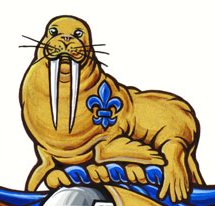 |
| Walrus, Face |
Crummey, JJSK. Vol V, P 340 |
The Walrus depicted in the badge is the Atlantic Walrus. The colours are those of Canada. |
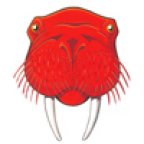 |
| Wapiti |
Gienow, D. M. Vol V, P 557 |
 The Wapiti or Elk (the main charge) is one of the supporters of the arms of British Columbia, where the grantee was born. It also represents his involvement in the protection of Canadian wildlife. The Wapiti or Elk (the main charge) is one of the supporters of the arms of British Columbia, where the grantee was born. It also represents his involvement in the protection of Canadian wildlife. |
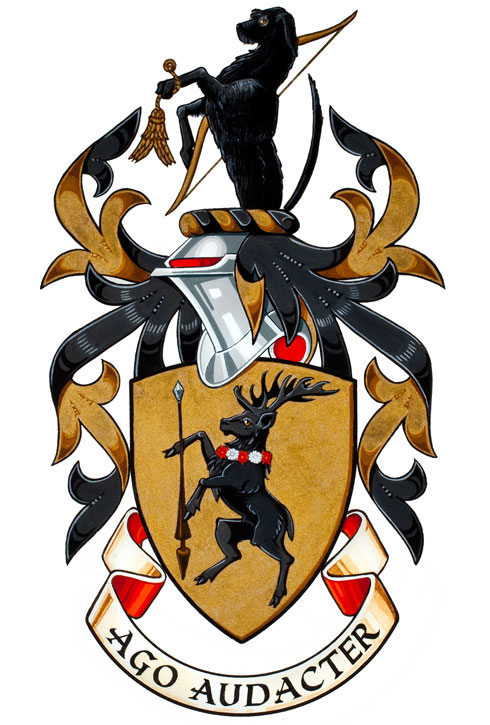 |
| Wapiti Stag |
B.C. Pharmacy Association. Vol II, P 367 |
 The Wapiti or Elk (shown here as the sinister supporter) is one of the largest species of the deer family, exceeded in size only by the moose. They live mainly in forested areas, extending westwards in Canada to the Rocky Mountains. Their huge antlers, amazingly, are shed and re-grown every year. The Wapiti or Elk (shown here as the sinister supporter) is one of the largest species of the deer family, exceeded in size only by the moose. They live mainly in forested areas, extending westwards in Canada to the Rocky Mountains. Their huge antlers, amazingly, are shed and re-grown every year. |
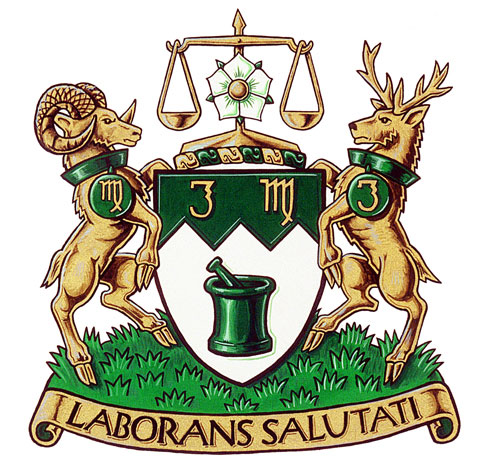 |
| Wasp |
2nd Tactical Aviation Wing, RCAF (Badge) Vol II, P 273 |
 The wasp is a universally-known flying insect with a dangerous sting. Its use suggests both flight and “stinging” attacks. The wasp is a universally-known flying insect with a dangerous sting. Its use suggests both flight and “stinging” attacks. |
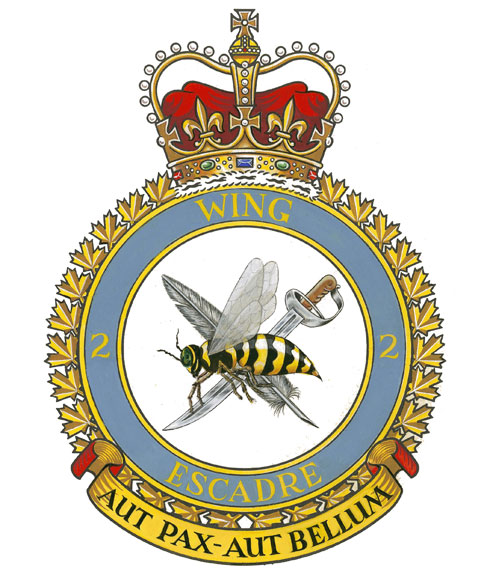 |
| Weeping Willow |
Parent, S.G.G. Vol II, P 69 |
 The Weeping Willow is an ornamental tree, distinguished by its drooping branches. Its wood is supple and used to make cricket bats and flutes. The tree itself may sometimes be a symbol of death or sadness. The Weeping Willow is an ornamental tree, distinguished by its drooping branches. Its wood is supple and used to make cricket bats and flutes. The tree itself may sometimes be a symbol of death or sadness. |
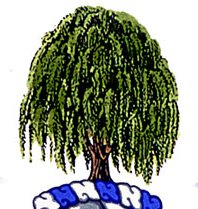 |
| Western Red Lily - Heraldic |
Province of Saskatchewan. (Flag) Vol VI, P 8 |
 The Western Red Lily (or Prairie Lily) is the Provincial flower of Saskatchewan. The Western Red Lily (or Prairie Lily) is the Provincial flower of Saskatchewan. |
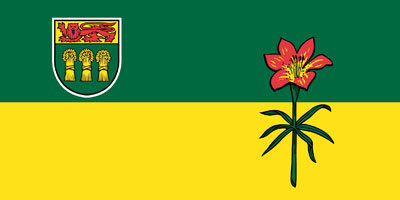 |
| Western Red Lily - Natural |
Provincial Flowers of Canada. |
 The Western Red Lily (or Prairie Lily), seen here in its natural form, is the Provincial flower of Saskatchewan. The Western Red Lily (or Prairie Lily), seen here in its natural form, is the Provincial flower of Saskatchewan. |
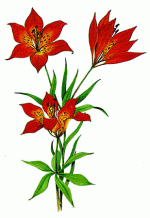 |
| Whale's Tail |
Nunasi Corporation. Vol VI, F-N P2 |
 The Whale’s Tail – shown here in the crest – symbolizes the importance of the whale to the traditional sustenance of the Inuit people. The Whale’s Tail – shown here in the crest – symbolizes the importance of the whale to the traditional sustenance of the Inuit people. |
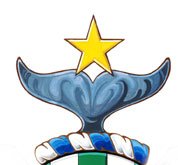 |
| White-tailed Deer |
Quispamsis, NB. Vol V, P 292 |
 The White-tailed Deer represent the Province of New Brunswick, which has similar supporters. The White-tailed Deer represent the Province of New Brunswick, which has similar supporters. |
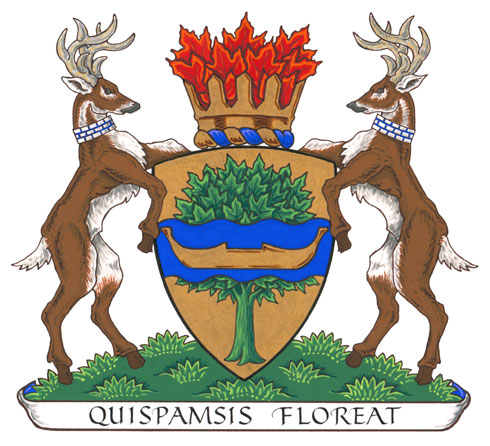 |
| White-tailed Tropicbird |
Fleming, C.A.M. Vol IV, P 309 |
 The White-Tailed Tropicbird is a seabird found in many tropical areas. It is used here to allude to the grantee’s birthplace in Bermuda. The White-Tailed Tropicbird is a seabird found in many tropical areas. It is used here to allude to the grantee’s birthplace in Bermuda. |
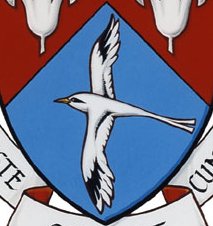 |
| Whitefish |
Corporation of Sault Ste. Marie. Vol VI, P 493 |
 The Whitefish is frequently found in the rapids of Sault Ste. Marie. The Whitefish is frequently found in the rapids of Sault Ste. Marie. |
 |
| Whooping Crane |
Whitford, A.W.J. Vol V, P 30 |
 The Whooping Crane – an endangered crane species named for its whooping cry – is native to North America, being its tallest bird. It is here used to allude to the qualities of gentleness, wisdom and grace. The Whooping Crane – an endangered crane species named for its whooping cry – is native to North America, being its tallest bird. It is here used to allude to the qualities of gentleness, wisdom and grace. |
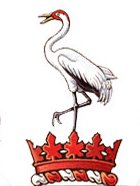 |
| Wild Columbine |
Village of Lions Bay, BC. Vol V, P190 |
The wild columbine held by the bear of the crest is the official flower of the village. |
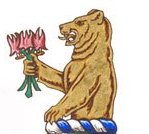 |
| Wild Rose - Natural |
Provincial Flowers of Canada |
 The Wild Rose (shown here in its natural form) is the Provincial Flower of Alberta. The Wild Rose (shown here in its natural form) is the Provincial Flower of Alberta. |
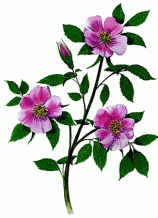 |
| Wild Rose - Heraldic |
41 Service Battalion. Vol VI 365 |
 The Wild Rose is the Provincial flower of Alberta. The Wild Rose is the Provincial flower of Alberta. |
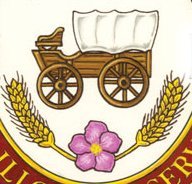 |
| Wind Turbine Blade |
Apold, W.O. (Badge) Vol IV, P 378 |
 The Wind Turbine Blades in this badge allude to the grantee’s abiding interest in wind power as a stable, renewable energy source. The Wind Turbine Blades in this badge allude to the grantee’s abiding interest in wind power as a stable, renewable energy source. |
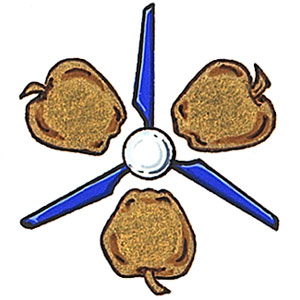 |
| Winged Bear |
Alexander, Lincoln. Vol II, P 104 |
 The Winged Bear, shown as the sinister supporter of His Honour’s arms, combines the body of a bear with the wings of an eagle. The Winged Bear, shown as the sinister supporter of His Honour’s arms, combines the body of a bear with the wings of an eagle. |
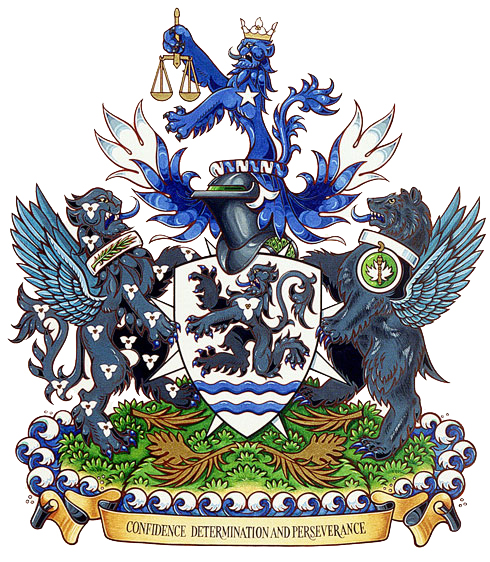 |
| Winged Bear #2 |
Capilano University, North Vancouver, BC. Vol V, P554 |
 In local First Nations mythology, Bears are symbols of strength. The Wings are symbols of aspiration. In local First Nations mythology, Bears are symbols of strength. The Wings are symbols of aspiration. |
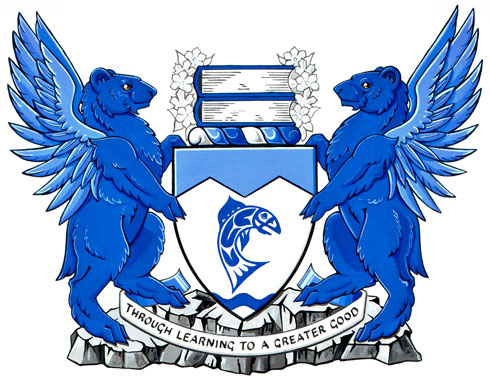 |
| Winged Beaver |
Bogie, J.M. Vol IV, P 127 |
 The beaver is of course the iconic Canadian animal. The winged version refers to the grantee’s association with flight. The beaver is of course the iconic Canadian animal. The winged version refers to the grantee’s association with flight. |
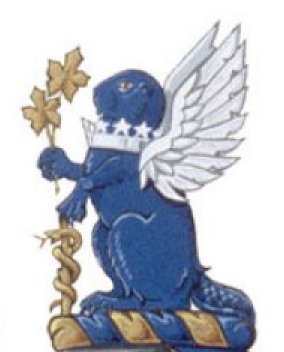 |
| Winged Bison |
Liba, P.M. (Winnipeg) Vol III, P 334 |
The Bison is symbolic of the Prairies, where the grantee lives. The wings are symbols of aspiration. |
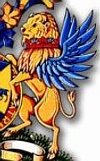 |
| Winged Book |
Larsen, D. Vol III, P 298 |
 The Winged Book suggests the logbook of a pilot and the grantee’s enthusiasm for flying. The Winged Book suggests the logbook of a pilot and the grantee’s enthusiasm for flying. |
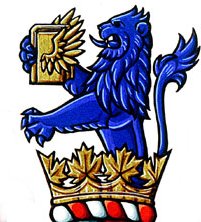 |
| Winged Bull |
St. Luke’s Anglican Church, Burlington, ON. Vol II, P 117 |
 St. Luke the Evangelist has traditionally been symbolized by a winged ox or bull – a figure of sacrifice, service and strength. St. Luke the Evangelist has traditionally been symbolized by a winged ox or bull – a figure of sacrifice, service and strength. |
 |
| Winged Bull #2 |
St. Luke’s Cathedral, Soult Ste. Marie. Vol III, P 46 |
 The Winged Bull, as shown in base, is a symbol of St. Luke. The Winged Bull, as shown in base, is a symbol of St. Luke. |
 |
| Winged Cat |
Batts, M. Vol IV, P 295 |
The wings on the cat are those of a bat, and therefore a rebus on the name of the grantee. |
 |
| Winged Cougar |
BC Institute of Technology. Vol. II, P 93 |
 The Cougar is a British Columbia creature, also known as the mountain lion or puma. The wings allude to the grantee’s program dedicated to aviation. The Cougar is a British Columbia creature, also known as the mountain lion or puma. The wings allude to the grantee’s program dedicated to aviation. |
 |
| Winged Doe |
Fawcett Family Association (Supporter) Vol IV, P 40 |
 The Winged Doe (seen here as the sinister supporter) alludes to the contributions of the women of the grantee’s family through the ages. The Winged Doe (seen here as the sinister supporter) alludes to the contributions of the women of the grantee’s family through the ages. |
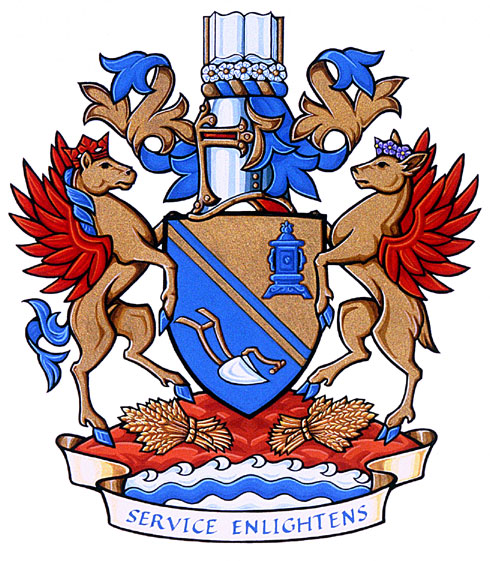 |
| Winged Husky Dog |
Norris, D.L. Vol II, P 182 |
 The Winged Husky Dog, as shown here as the sinister supporter, refers to the Northwest Territories, where the grantee’s home of Yellowknife is located. The wings may refer to the main modern means of transportation in the Canadian north. The Winged Husky Dog, as shown here as the sinister supporter, refers to the Northwest Territories, where the grantee’s home of Yellowknife is located. The wings may refer to the main modern means of transportation in the Canadian north. |
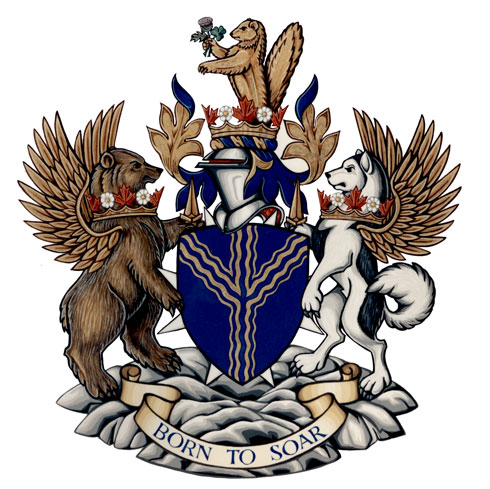 |
| Winged Irish Wolfhound |
McKenna, M. J. Vol III, P 107 |
 The Irish Wolfhound is a very large “sight hound” from Ireland. The name originates from its purpose, wolf hunting with dogs, rather than its appearance. It is the tallest of all dog breeds. The wings allude to the grantee’s interest in flying. The Irish Wolfhound is a very large “sight hound” from Ireland. The name originates from its purpose, wolf hunting with dogs, rather than its appearance. It is the tallest of all dog breeds. The wings allude to the grantee’s interest in flying. |
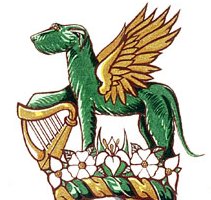 |
| Winged Lion |
Alexander, Lincoln. Vol II, P 104 |
 The Winged Lion, the dexter supporter of His Honour’s arms, combines the body of a lion (the main charge on the shield) with the wings of an eagle. The Winged Lion, the dexter supporter of His Honour’s arms, combines the body of a lion (the main charge on the shield) with the wings of an eagle. |
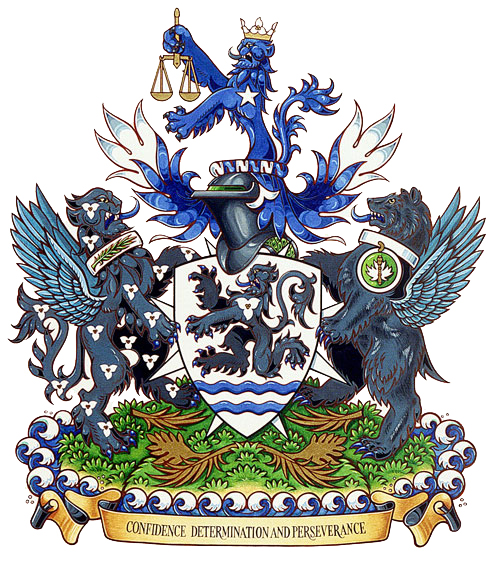 |
| Winged Polar Bear |
Canadian Society of Immigration Consultants. Vol V, P 493 |
 The Polar Bears are Canadian animals famous for protecting their young. The wings express the idea of migration. The Polar Bears are Canadian animals famous for protecting their young. The wings express the idea of migration. |
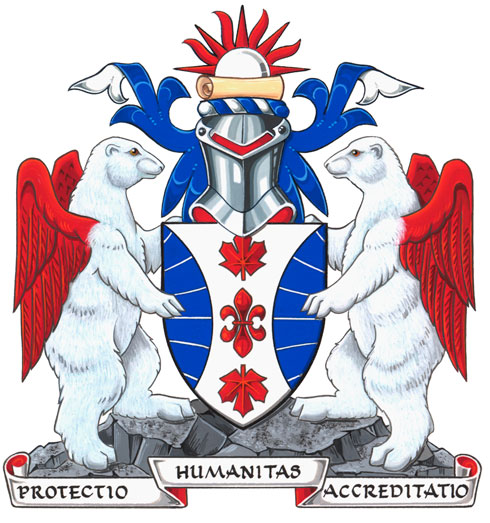 |
| Winged Salamander |
Douglas, D.A. Vol V, P 532 |
 The Salamander is a mythical Beast impervious to fire. The wings in this case refer to the Grantee’s love of travel. The Salamander is a mythical Beast impervious to fire. The wings in this case refer to the Grantee’s love of travel. |
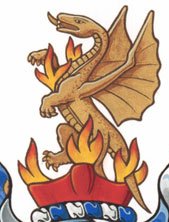 |
| Winged Schnauzer |
Dorosz, C. M. Vol V, P306 |
 The Schnauzer relates to the Swiss- German origins of the grantee. The wings refer to the Pollexfen family. Mr Dorosz’s maternal ancestors. The Schnauzer relates to the Swiss- German origins of the grantee. The wings refer to the Pollexfen family. Mr Dorosz’s maternal ancestors. |
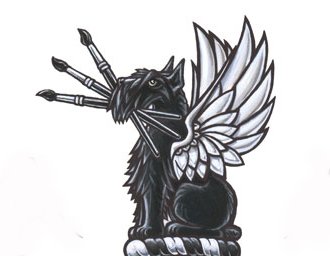 |
| Winged Sea Caribou (male & female) |
Federal Court. Vol V, P191 |
 The winged Sea Caribou is a mythical creature representing the Court’s involvement with issues on the land, sea and in the air. The male and female supporters represent the equality of the sexes as well as the fact that the Court is composed of male and female judicial officers. The winged Sea Caribou is a mythical creature representing the Court’s involvement with issues on the land, sea and in the air. The male and female supporters represent the equality of the sexes as well as the fact that the Court is composed of male and female judicial officers. |
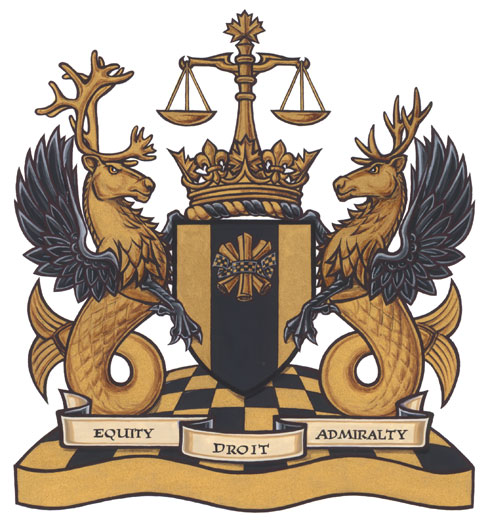 |
| Winged Sea Cougar |
Van Horne, Lee. Vol V, P 165 |
The Cougar is native to Vancouver Island, the grantee’s home. The wings refer to his hobby as a recreational pilot, while the tail alludes to his service in the Canadian Coast Guard. |
 |
| Winged Sea Horse |
Chiasson, H. Vol. IV, P 379 |
 The Winged Horse (or Pegasus) is used here as a symbol of poetic inspiration. The fish-tails allude to New Brunswick’s maritime geography. The Winged Horse (or Pegasus) is used here as a symbol of poetic inspiration. The fish-tails allude to New Brunswick’s maritime geography. |
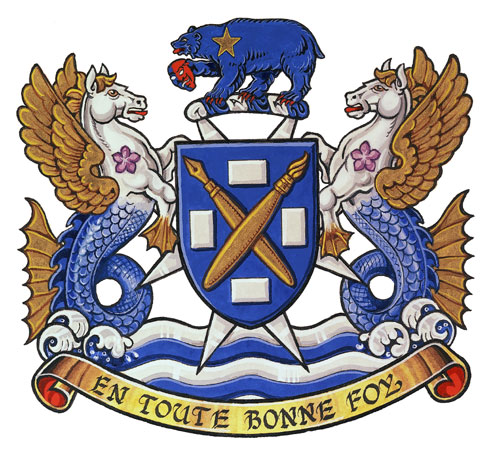 |
| Winged Sea Lion |
DND Assistant Deputy Minister, Personnel (Badge) Vol II, P 420 |
 The Winged Sea Lion is an heraldic creature appropriately symbolic of the Air, Sea and Land elements of the Canadian Forces. The Winged Sea Lion is an heraldic creature appropriately symbolic of the Air, Sea and Land elements of the Canadian Forces. |
 |
| Winged Sea Lion #2 |
Gibson, R. J. S. Vol IV, P 240 |
 The Winged Sea Lion alludes appropriately in this case to the grantee’s service in both the Army and Navy, but may in general refer any land/sea/air activities. The Winged Sea Lion alludes appropriately in this case to the grantee’s service in both the Army and Navy, but may in general refer any land/sea/air activities. |
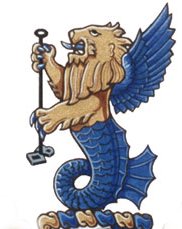 |
| Winged Sea Ram |
Canadian War Museum. Vol. III, P 340 |
 The Winged Sea Ram combines the features of the air, sea and land elements of the Canadian Forces. The Winged Sea Ram combines the features of the air, sea and land elements of the Canadian Forces. |
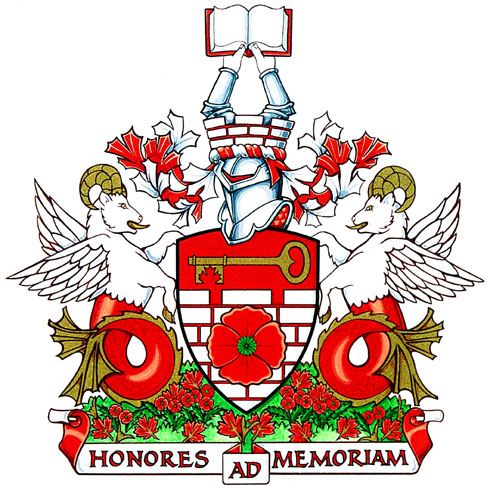 |
| Winged Siberian Tiger |
Martin, P.E.P. Vol VI, P 265 |
 The Siberian Tiger is here depicted with wings in the West Coast aboriginal style. The Siberian Tiger is here depicted with wings in the West Coast aboriginal style. |
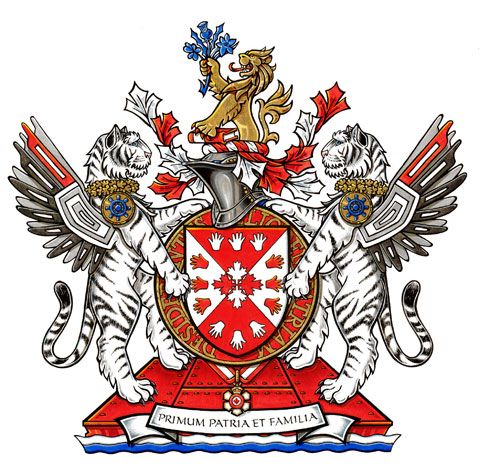 |
| Winged Stag |
Scott, R.L. Vol IV, P 374 |
 The stag is traditional to the Clan Scott. The wings are added to allude to the grantee’s service in the RCAF. The stag is traditional to the Clan Scott. The wings are added to allude to the grantee’s service in the RCAF. |
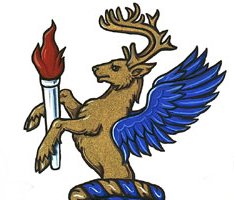 |
| Winged Stallion |
Fawcett Family Association (Supporter) Vol IV, P 40 |
 The Winged Stallion (seen here as the dexter supporter) represents the agricultural heritage of the grantee’s family, with the flame-like wings symbolizing their service to the Church, education and family business. The Winged Stallion (seen here as the dexter supporter) represents the agricultural heritage of the grantee’s family, with the flame-like wings symbolizing their service to the Church, education and family business. |
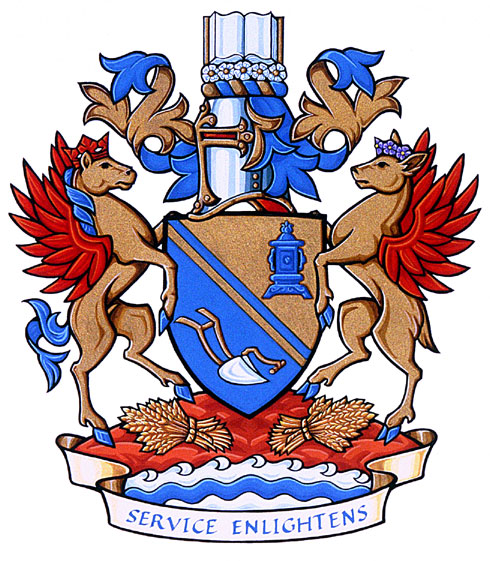 |
| Winged Tiger |
Cook, B.G. Vol V, P 467 |
 The Tiger refers in this case to the Grantee’s Indian background. The wings allude to his love of travel. The Tiger refers in this case to the Grantee’s Indian background. The wings allude to his love of travel. |
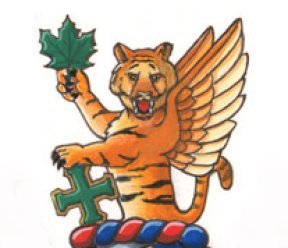 |
| Winged Wolf |
Bradford, W.W.R. Vol IV, P 183 |
 The wolf is derived from the grantee’s family arms of Yorkshire, England. The wings allude to his Royal Canadian Air Force service. The wolf is derived from the grantee’s family arms of Yorkshire, England. The wings allude to his Royal Canadian Air Force service. |
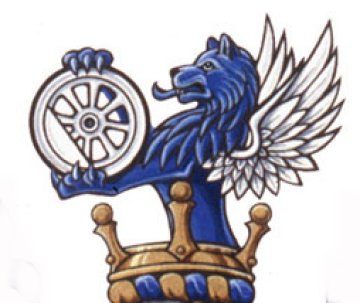 |
| Wolf - Tlingit Style |
Gingell, J. Vol III, P 272 |
 The sinister supporter in these arms depicts a wolf, in the style of the Tlingit First Nation of the Yukon. The sinister supporter in these arms depicts a wolf, in the style of the Tlingit First Nation of the Yukon. |
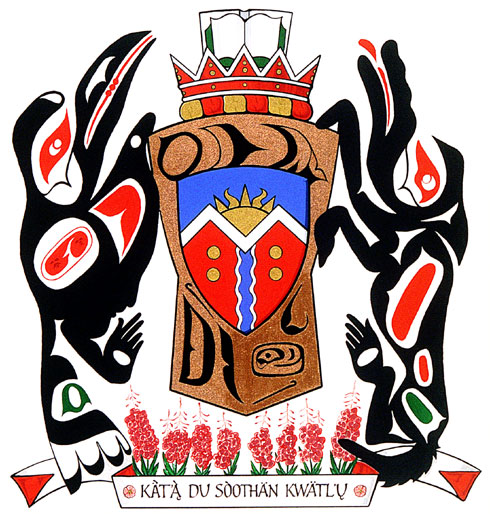 |
| Wolf - Coast Salish Style |
Victoria Police Department. (Badge) Vol V, P 530 |
 The Wolf (in chief) is shown in the style of the Coast Salish people. The Wolf (in chief) is shown in the style of the Coast Salish people. |
 |
| Wolf-Raven |
City of Whitehorse. Vol IV, P 253 |
 The sinister supporter, a combination of the body of a wolf with the wings and claws of a raven, honours the two clans of the Yukon First Nation, the Wolf and the Raven Clans. It also celebrates the original inhabitants of the region and their importance in the life of the present-day capital. The sinister supporter, a combination of the body of a wolf with the wings and claws of a raven, honours the two clans of the Yukon First Nation, the Wolf and the Raven Clans. It also celebrates the original inhabitants of the region and their importance in the life of the present-day capital. |
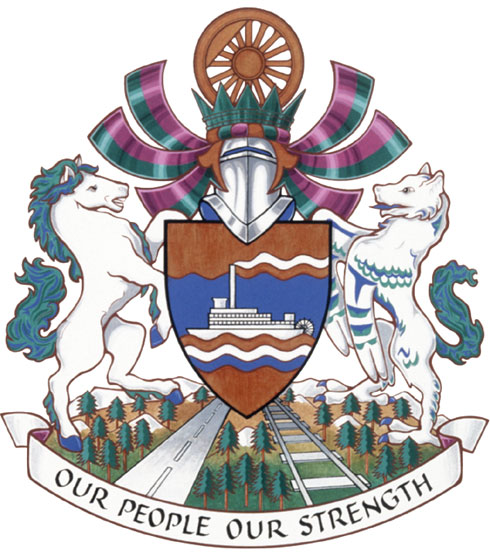 |
| Wolverine |
Tremblay, P. Vol VI, P 85 |
 The wolverine possesses unequalled ferocity, making it a formidable adversary. Considered by the Innu to be the creator of the world, it represents force, and thus the notion of total commitment. The wolverine possesses unequalled ferocity, making it a formidable adversary. Considered by the Innu to be the creator of the world, it represents force, and thus the notion of total commitment. |
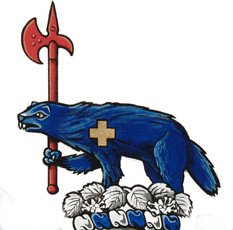 |
 Canadian Heraldic Dictionary
Canadian Heraldic Dictionary Canadian Heraldic Dictionary
Canadian Heraldic Dictionary

 The Walrus (seen here in its full form) is a large flippered marine mammal, native to the Arctic Ocean.
The Walrus (seen here in its full form) is a large flippered marine mammal, native to the Arctic Ocean. 

 The Wapiti or Elk (the main charge) is one of the supporters of the arms of British Columbia, where the grantee was born. It also represents his involvement in the protection of Canadian wildlife.
The Wapiti or Elk (the main charge) is one of the supporters of the arms of British Columbia, where the grantee was born. It also represents his involvement in the protection of Canadian wildlife.
 The Wapiti or Elk (shown here as the sinister supporter) is one of the largest species of the deer family, exceeded in size only by the moose. They live mainly in forested areas, extending westwards in Canada to the Rocky Mountains. Their huge antlers, amazingly, are shed and re-grown every year.
The Wapiti or Elk (shown here as the sinister supporter) is one of the largest species of the deer family, exceeded in size only by the moose. They live mainly in forested areas, extending westwards in Canada to the Rocky Mountains. Their huge antlers, amazingly, are shed and re-grown every year.
 The wasp is a universally-known flying insect with a dangerous sting. Its use suggests both flight and “stinging” attacks.
The wasp is a universally-known flying insect with a dangerous sting. Its use suggests both flight and “stinging” attacks.
 The Weeping Willow is an ornamental tree, distinguished by its drooping branches. Its wood is supple and used to make cricket bats and flutes. The tree itself may sometimes be a symbol of death or sadness.
The Weeping Willow is an ornamental tree, distinguished by its drooping branches. Its wood is supple and used to make cricket bats and flutes. The tree itself may sometimes be a symbol of death or sadness.
 The Western Red Lily (or Prairie Lily) is the Provincial flower of Saskatchewan.
The Western Red Lily (or Prairie Lily) is the Provincial flower of Saskatchewan. 
 The Western Red Lily (or Prairie Lily), seen here in its natural form, is the Provincial flower of Saskatchewan.
The Western Red Lily (or Prairie Lily), seen here in its natural form, is the Provincial flower of Saskatchewan.
 The Whale’s Tail – shown here in the crest – symbolizes the importance of the whale to the traditional sustenance of the Inuit people.
The Whale’s Tail – shown here in the crest – symbolizes the importance of the whale to the traditional sustenance of the Inuit people. 
 The White-tailed Deer represent the Province of New Brunswick, which has similar supporters.
The White-tailed Deer represent the Province of New Brunswick, which has similar supporters.
 The White-Tailed Tropicbird is a seabird found in many tropical areas. It is used here to allude to the grantee’s birthplace in Bermuda.
The White-Tailed Tropicbird is a seabird found in many tropical areas. It is used here to allude to the grantee’s birthplace in Bermuda.
 The Whitefish is frequently found in the rapids of Sault Ste. Marie.
The Whitefish is frequently found in the rapids of Sault Ste. Marie. 
 The Whooping Crane – an endangered crane species named for its whooping cry – is native to North America, being its tallest bird. It is here used to allude to the qualities of gentleness, wisdom and grace.
The Whooping Crane – an endangered crane species named for its whooping cry – is native to North America, being its tallest bird. It is here used to allude to the qualities of gentleness, wisdom and grace.

 The Wild Rose (shown here in its natural form) is the Provincial Flower of Alberta.
The Wild Rose (shown here in its natural form) is the Provincial Flower of Alberta.
 The Wild Rose is the Provincial flower of Alberta.
The Wild Rose is the Provincial flower of Alberta.
 The Wind Turbine Blades in this badge allude to the grantee’s abiding interest in wind power as a stable, renewable energy source.
The Wind Turbine Blades in this badge allude to the grantee’s abiding interest in wind power as a stable, renewable energy source.
 The Winged Bear, shown as the sinister supporter of His Honour’s arms, combines the body of a bear with the wings of an eagle.
The Winged Bear, shown as the sinister supporter of His Honour’s arms, combines the body of a bear with the wings of an eagle.
 In local First Nations mythology, Bears are symbols of strength. The Wings are symbols of aspiration.
In local First Nations mythology, Bears are symbols of strength. The Wings are symbols of aspiration.
 The beaver is of course the iconic Canadian animal. The winged version refers to the grantee’s association with flight.
The beaver is of course the iconic Canadian animal. The winged version refers to the grantee’s association with flight.

 The Winged Book suggests the logbook of a pilot and the grantee’s enthusiasm for flying.
The Winged Book suggests the logbook of a pilot and the grantee’s enthusiasm for flying.
 St. Luke the Evangelist has traditionally been symbolized by a winged ox or bull – a figure of sacrifice, service and strength.
St. Luke the Evangelist has traditionally been symbolized by a winged ox or bull – a figure of sacrifice, service and strength.
 The Winged Bull, as shown in base, is a symbol of St. Luke.
The Winged Bull, as shown in base, is a symbol of St. Luke.

 The Cougar is a British Columbia creature, also known as the mountain lion or puma. The wings allude to the grantee’s program dedicated to aviation.
The Cougar is a British Columbia creature, also known as the mountain lion or puma. The wings allude to the grantee’s program dedicated to aviation.
 The Winged Doe (seen here as the sinister supporter) alludes to the contributions of the women of the grantee’s family through the ages.
The Winged Doe (seen here as the sinister supporter) alludes to the contributions of the women of the grantee’s family through the ages.
 The Winged Husky Dog, as shown here as the sinister supporter, refers to the Northwest Territories, where the grantee’s home of Yellowknife is located. The wings may refer to the main modern means of transportation in the Canadian north.
The Winged Husky Dog, as shown here as the sinister supporter, refers to the Northwest Territories, where the grantee’s home of Yellowknife is located. The wings may refer to the main modern means of transportation in the Canadian north.
 The Irish Wolfhound is a very large “sight hound” from Ireland. The name originates from its purpose, wolf hunting with dogs, rather than its appearance. It is the tallest of all dog breeds. The wings allude to the grantee’s interest in flying.
The Irish Wolfhound is a very large “sight hound” from Ireland. The name originates from its purpose, wolf hunting with dogs, rather than its appearance. It is the tallest of all dog breeds. The wings allude to the grantee’s interest in flying.
 The Winged Lion, the dexter supporter of His Honour’s arms, combines the body of a lion (the main charge on the shield) with the wings of an eagle.
The Winged Lion, the dexter supporter of His Honour’s arms, combines the body of a lion (the main charge on the shield) with the wings of an eagle.
 The Polar Bears are Canadian animals famous for protecting their young. The wings express the idea of migration.
The Polar Bears are Canadian animals famous for protecting their young. The wings express the idea of migration.
 The Salamander is a mythical Beast impervious to fire. The wings in this case refer to the Grantee’s love of travel.
The Salamander is a mythical Beast impervious to fire. The wings in this case refer to the Grantee’s love of travel.
 The Schnauzer relates to the Swiss- German origins of the grantee. The wings refer to the Pollexfen family. Mr Dorosz’s maternal ancestors.
The Schnauzer relates to the Swiss- German origins of the grantee. The wings refer to the Pollexfen family. Mr Dorosz’s maternal ancestors.
 The winged Sea Caribou is a mythical creature representing the Court’s involvement with issues on the land, sea and in the air. The male and female supporters represent the equality of the sexes as well as the fact that the Court is composed of male and female judicial officers.
The winged Sea Caribou is a mythical creature representing the Court’s involvement with issues on the land, sea and in the air. The male and female supporters represent the equality of the sexes as well as the fact that the Court is composed of male and female judicial officers. 

 The Winged Horse (or Pegasus) is used here as a symbol of poetic inspiration. The fish-tails allude to New Brunswick’s maritime geography.
The Winged Horse (or Pegasus) is used here as a symbol of poetic inspiration. The fish-tails allude to New Brunswick’s maritime geography.
 The Winged Sea Lion is an heraldic creature appropriately symbolic of the Air, Sea and Land elements of the Canadian Forces.
The Winged Sea Lion is an heraldic creature appropriately symbolic of the Air, Sea and Land elements of the Canadian Forces.
 The Winged Sea Lion alludes appropriately in this case to the grantee’s service in both the Army and Navy, but may in general refer any land/sea/air activities.
The Winged Sea Lion alludes appropriately in this case to the grantee’s service in both the Army and Navy, but may in general refer any land/sea/air activities.
 The Winged Sea Ram combines the features of the air, sea and land elements of the Canadian Forces.
The Winged Sea Ram combines the features of the air, sea and land elements of the Canadian Forces.
 The Siberian Tiger is here depicted with wings in the West Coast aboriginal style.
The Siberian Tiger is here depicted with wings in the West Coast aboriginal style. 
 The stag is traditional to the Clan Scott. The wings are added to allude to the grantee’s service in the RCAF.
The stag is traditional to the Clan Scott. The wings are added to allude to the grantee’s service in the RCAF.
 The Winged Stallion (seen here as the dexter supporter) represents the agricultural heritage of the grantee’s family, with the flame-like wings symbolizing their service to the Church, education and family business.
The Winged Stallion (seen here as the dexter supporter) represents the agricultural heritage of the grantee’s family, with the flame-like wings symbolizing their service to the Church, education and family business.
 The Tiger refers in this case to the Grantee’s Indian background. The wings allude to his love of travel.
The Tiger refers in this case to the Grantee’s Indian background. The wings allude to his love of travel.
 The wolf is derived from the grantee’s family arms of Yorkshire, England. The wings allude to his Royal Canadian Air Force service.
The wolf is derived from the grantee’s family arms of Yorkshire, England. The wings allude to his Royal Canadian Air Force service.
 The sinister supporter in these arms depicts a wolf, in the style of the Tlingit First Nation of the Yukon.
The sinister supporter in these arms depicts a wolf, in the style of the Tlingit First Nation of the Yukon.
 The Wolf (in chief) is shown in the style of the Coast Salish people.
The Wolf (in chief) is shown in the style of the Coast Salish people.
 The sinister supporter, a combination of the body of a wolf with the wings and claws of a raven, honours the two clans of the Yukon First Nation, the Wolf and the Raven Clans. It also celebrates the original inhabitants of the region and their importance in the life of the present-day capital.
The sinister supporter, a combination of the body of a wolf with the wings and claws of a raven, honours the two clans of the Yukon First Nation, the Wolf and the Raven Clans. It also celebrates the original inhabitants of the region and their importance in the life of the present-day capital.
 The wolverine possesses unequalled ferocity, making it a formidable adversary. Considered by the Innu to be the creator of the world, it represents force, and thus the notion of total commitment.
The wolverine possesses unequalled ferocity, making it a formidable adversary. Considered by the Innu to be the creator of the world, it represents force, and thus the notion of total commitment. 